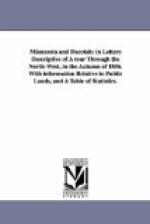It has been under the charge of Rev. J. L. Breck,
a gentleman of high culture, and whose enlightened
and humane exertions in behalf of the Indians have
received much commendation both from the agent and
Gov. Gorman, the Superintendent. He has
been at the mission four years. While he had
the benefit of the school-fund, he had in his school,
under his own roof, 35 pupils; since that was withheld,
the number of pupils has been 22. Mr. Breck will
soon remove to Leech Lake, and will be succeeded by
a gentleman who comes well recommended from a theological
institution in Wisconsin. I desired very much
to go as far as the mission, but from Crow Wing and
back it would have been thirty miles, and it was otherwise
inconvenient on account of the rain. The Indians
are beginning to farm a little. They begin with
gardens. Their support is chiefly from the annuities
paid by the United States, which are principally received
in some sort of dry goods. The goods are furnished
by contract, and the price paid for them is about enough,
if all stories are true. They also derive some
support from their fur hunts and by fishing.
Buffaloes are still hunted successfully beyond the
Red River of the North. They bring home the furs,
and also the best parts of the meat. The meat
is preserved by being partially cooked in buffalo
fat, cut into small pieces, and sewed up very tight
in the hide of the animal. It is called pemmican,
and sells here for twenty-five cents a pound.
It is broken to pieces like pork scraps, and the Indians
regard it as a great luxury.
From the agency I hastened on to see Hole-in-the-day
(Pug-o-na-ke-shick, his Indian name, means, literally,
Hole-in-the-sky). He is a famous chief, having
in his youth distinguished himself for bold exploits
and severe endurance. But what most entitles
him to attention is the very exemplary course he has
pursued in attempting to carry out the wishes of the
government in bringing his race to the habits of civilized
life. It was principally through his influence
that a treaty was made between his tribe and the United
States, and after it went into effect he turned his
attention to farming. Previous to the treaty
he was supported as chief by the tribal revenue.
He has succeeded well. Over a year ago the receipts
of what he sold from his farm, aside from what his
household needed, amounted to over two hundred dollars.
At length, after riding a mile and a half without
passing a habitation, over a fertile prairie, I came
in sight of his house. He lives near a small lake,
and north of him is a large belt of heavy pine timber.
He has an excellent farm, well fenced and well cultivated.
His house is in cottage style, and of considerable
length; spacious, neat, and well furnished. Arriving
at the door I dismounted, and inquired of his squaw
if he was at home. She sent her little girl out
into the field to call him. There, indeed, in
his cornfield, was he at work. He met me very
cordially; and invited me into a room, where he had




